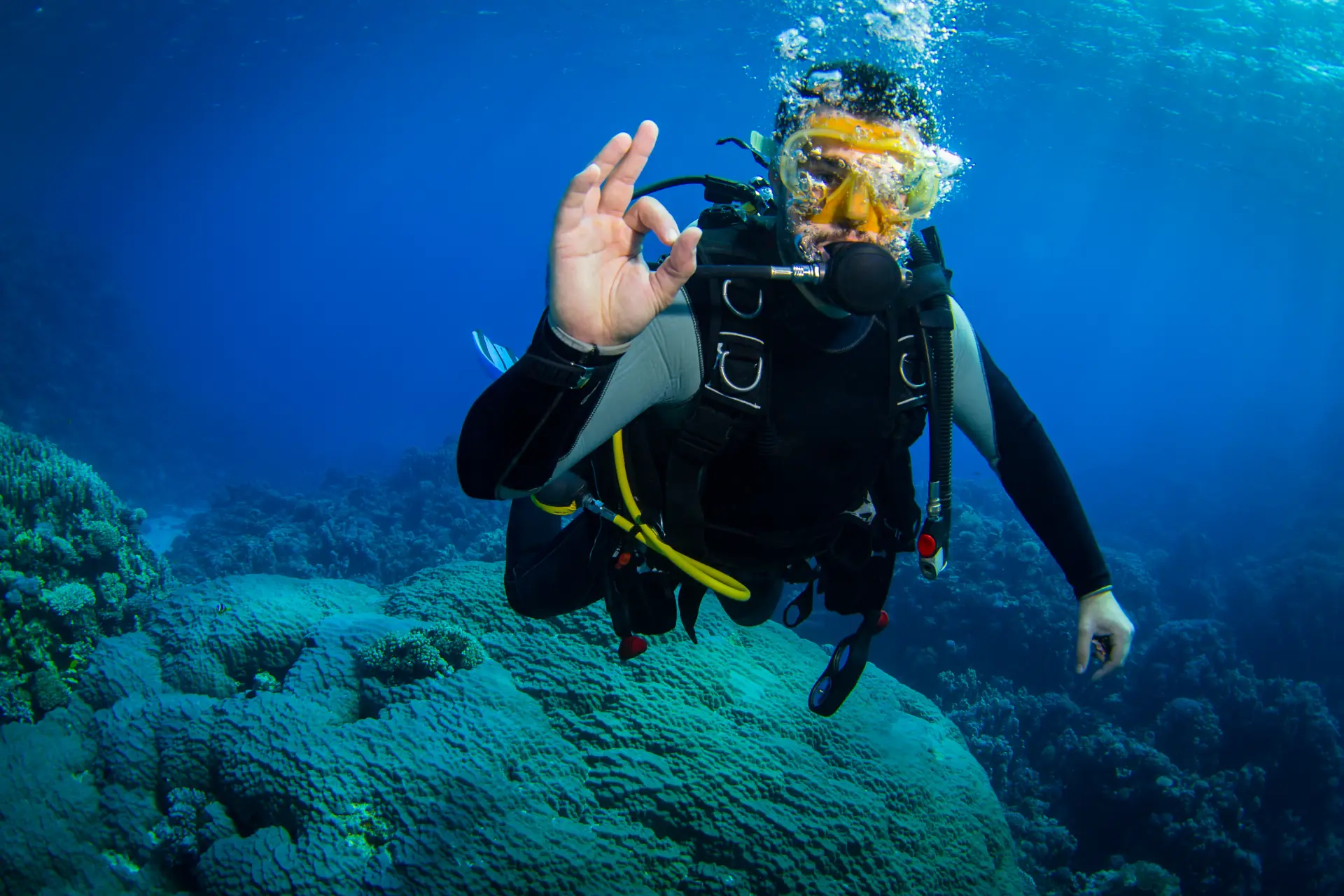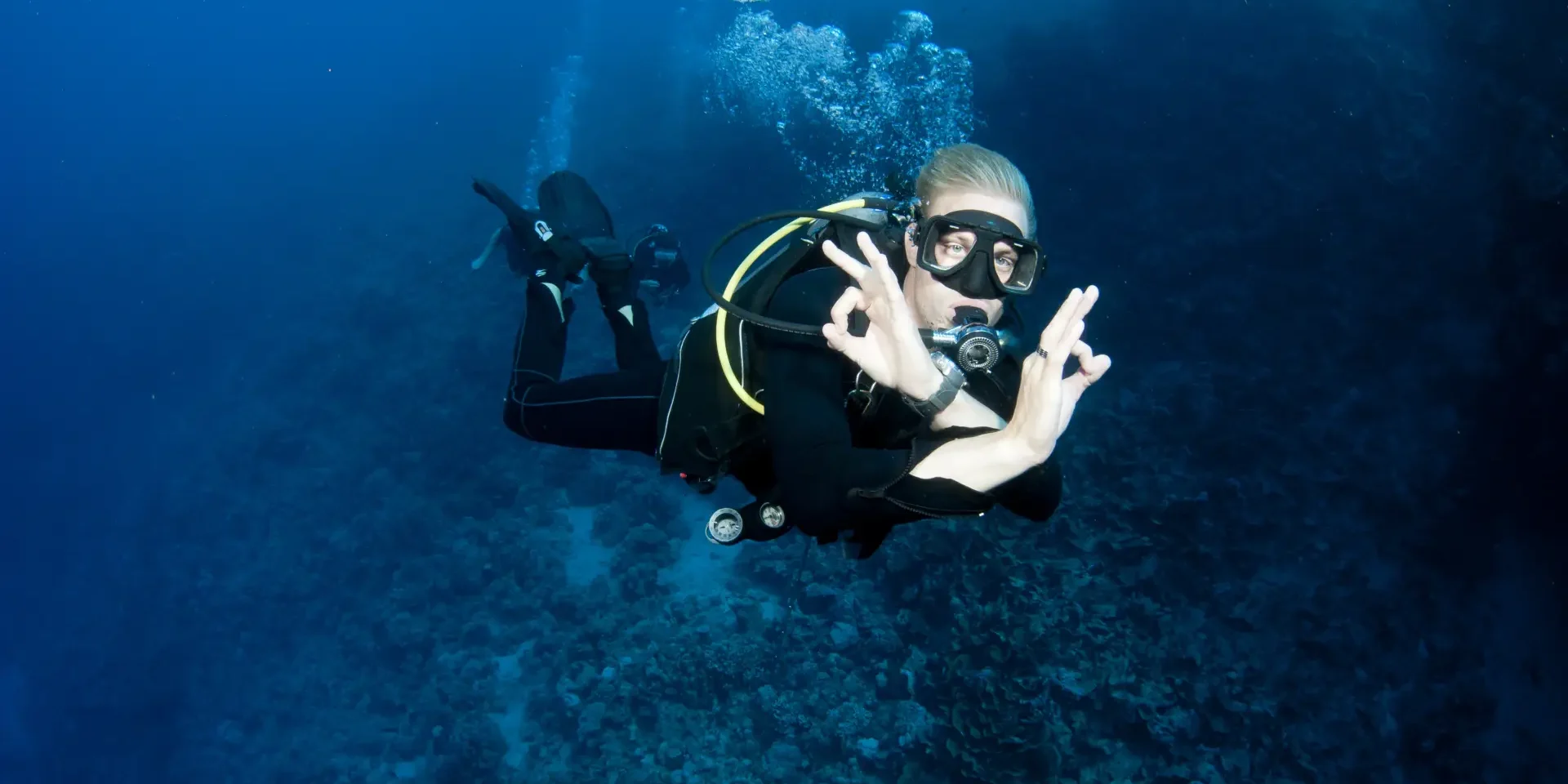Breathe Easy: 7 Simple Tips to Improve Your Air Consumption and Extend Your Dives
It’s the signal no diver wants to be the first to give: a flat hand across the chest, followed by the “T” signal. “Half tank.” A few minutes later, the inevitable raised fist. “Low on air.” Watching the rest of the group continue to explore a beautiful reef while you and your buddy make a mandatory ascent is one of the most common frustrations in scuba diving.
Many divers believe that air consumption is just an unchangeable fact—some people are “air hogs” and others are “sippers.” But that’s a myth. While body size and metabolism play a role, good air consumption is, above all, a skill. It’s a set of habits and techniques that can be learned, practiced, and mastered.
At Scubadore Hurghada, our goal is to help you become a relaxed, confident, and efficient diver. A longer dive is a more relaxed dive, and a more relaxed dive is a more enjoyable one. Our small-group, expert-led approach is the perfect environment to practice these skills.
Here are seven of our top tips to help you improve your air consumption, stay down longer, and get the absolute most out of every single dive in the Red Sea.

1. Slow Down. Then Slow Down Some More.
This is the golden rule. If you take away only one piece of advice, let it be this. Rushing is the number one enemy of good air consumption. The underwater world is not a racetrack; it’s a museum.
- The “Why”: Physics. Water is 800 times denser than air. The faster you try to move, the more resistance (drag) you create. To overcome that drag, your muscles must work exponentially harder. Harder work demands more oxygen, and your breathing rate skyrockets.
- The “How”: Adopt a “zen” mindset. Pretend you are moving in slow motion. Your fin kicks should be slow, deliberate, and powerful, originating from your hip. Between kicks, glide. Use the momentum to propel you forward. When you find something interesting, stop. Hover. Observe. By simply slowing your pace by 25%, you can dramatically reduce your air consumption.

2. Master Your Buoyancy: Stop Fighting the Water
This is the most important technical skill for air consumption. If you are constantly fidgeting with your BCD inflator, you are wasting an enormous amount of air. A diver with poor buoyancy is in a constant, air-wasting battle with the water.
- The “Why”: Think of the “yo-yo” diver. They kick to go up, then realize they’re too high and dump air from their BCD. They sink too low, then add a big puff of air to their BCD, only to start ascending again. That air added to the BCD is air that came directly from your tank and served no purpose for breathing. Furthermore, constantly finning to maintain your depth (instead of being neutrally buoyant) is exhausting.
- The “How”: Get your weighting right (see Tip #4) and learn to use your lungs as your primary buoyancy tool. A deep, full inhale will cause you to rise slightly. A long, full exhale will cause you to sink slightly. Mastering this allows for fine-tuned control without ever touching your inflator. This is the single best skill you can learn, which is why we always recommend the PADI Peak Performance Buoyancy (PPB) specialty course.
3. Breathe Deeply and Slowly (It’s Counterintuitive!)
Many new divers, in an attempt to “save” air, make the critical mistake of taking small, shallow sips. This actually makes you breathe more.
- The “Why”: Your body’s reflex to breathe is triggered not by a lack of oxygen, but by a build-up of carbon dioxide (CO2). Shallow breathing is inefficient; it doesn’t fully flush the CO2 from your lungs. This CO2 build-up quickly triggers your brain to take another breath… and another… and another. This is called “skip breathing,” and it’s stressful and inefficient.
- The “How”: Think like a yoga master. Take long, slow, deep, and deliberate breaths. A full, relaxed inhale (filling your lungs completely) followed by a long, complete exhale (emptying your lungs fully) is the most efficient way to exchange gasses. It purges the CO2, satisfies your body’s need for oxygen in one go, and keeps your brain calm, which brings us to…
4. Get Your Weighting Right
This is a core component of mastering buoyancy, but it’s so important it deserves its own point. Being overweighted is perhaps the most common mistake we see, and it’s a massive air-waster.
- The “Why”: It creates a disastrous chain reaction. If you are carrying too much lead, you sink like a rock. To compensate, you must add more air to your BCD. This extra air makes your BCD (and you) a larger, less hydrodynamic profile. This “inflated balloon” shape creates significantly more drag as you try to swim, which requires more finning effort, which, as we know, burns more air.
- The “How”: At the start of your dive trip, ask your guide to help you perform a proper weight check. A good starting point is to see if you can float at eye level at the surface with an empty BCD and a nearly empty tank (around 50 bar / 700 psi).
5. Stay Calm and Relax
Your state of mind is directly connected to your air gauge. Anxiety is an air-guzzler.
- The “Why”: When you feel nervous, cold, or task-loaded, your body enters a low-key “fight or flight” mode. Your heart rate increases, your muscles tense, and your breathing becomes rapid and shallow. This burns through your air supply at an astonishing rate.
- The “How”: Trust your training, your equipment, and your guide. This is where the Scubadore philosophy is your best friend. Diving in a small, supportive group with an expert, attentive guide is the best antidote to stress. You know you are being watched over, so you can relax, focus on your deep breathing, and just enjoy the scenery.
6. Streamline Your Gear (Reduce Drag)
Think of yourself as a sports car. You want to be as sleek and hydrodynamic as possible. Every piece of equipment dangling from your body creates drag.
- The “Why”: Drag is resistance. Resistance requires effort to overcome. Effort consumes oxygen. A console dangling a foot below you, a “safety sausage” unclipped, or a camera system dragging in the water are all acting like mini-parachutes, forcing you to work harder (and breathe more) on every single fin kick.
- The “How”: Get streamlined. Clip your octopus (alternate air source) and your gauges (console) to your BCD so they are tight against your body. Secure all your accessories. This not only saves you air but also protects the fragile coral reef from being damaged by your gear.
7. Stay Warm
Your body is a furnace. When you get cold, that furnace has to work overtime to generate heat and maintain your core temperature.
- The “Why”: This process of thermoregulation is a form of increased metabolism. A higher metabolism burns more energy and requires more oxygen to fuel it. The result? Your breathing rate increases significantly, even if you are perfectly calm and buoyant.
- The “How”: Don’t be a hero. Wear the appropriate thermal protection for the water temperature. In the warm summer months in Hurghada, a 3mm shorty might be perfect. In the cooler winter months, a 5mm or 7mm full suit is the right choice. We provide a full range of high-quality, well-maintained wetsuits to ensure you are always comfortable, allowing your body to relax and conserve energy.
Don’t be discouraged if you’re always the first one back on the boat. Good air consumption is a skill developed through practice and mindfulness. On your next dive, don’t try to fix all seven things at once. Just pick one or two—like “slow down” and “breathe deeply”—and focus on them. You’ll be amazed at the results.







